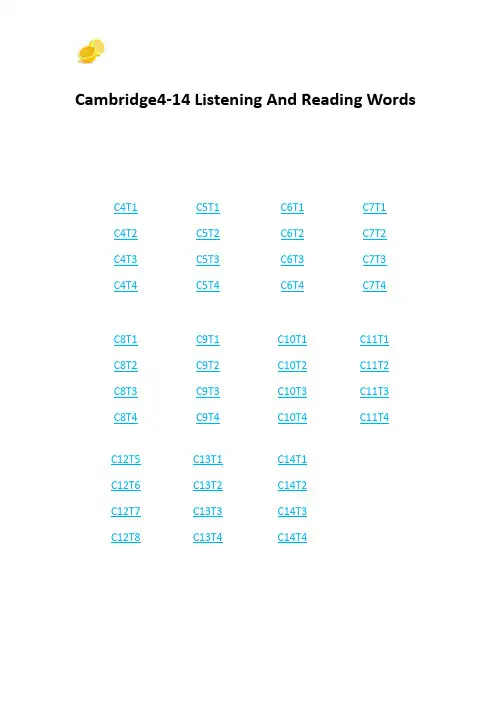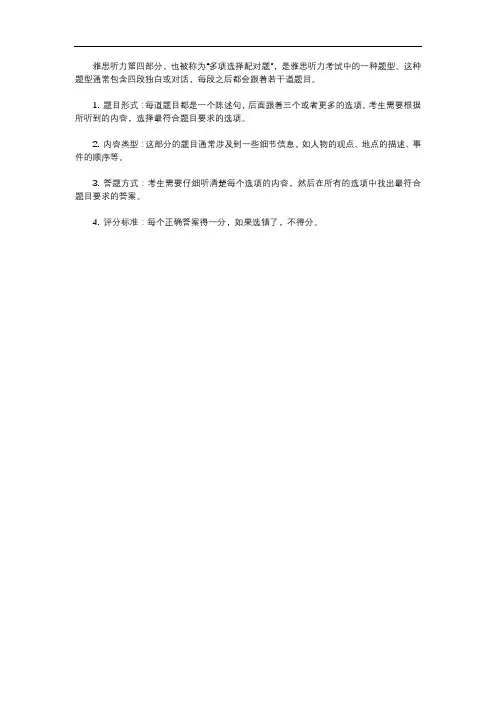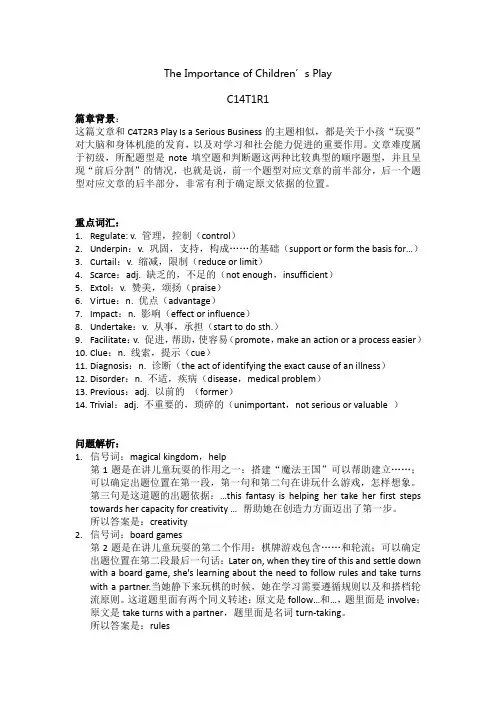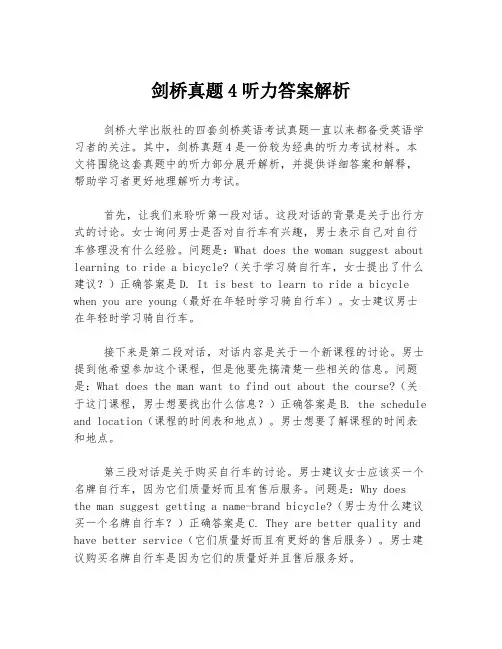剑桥系列雅思听力题型整理4-14
雅思 A类 剑桥4-14 听力阅读 常考题干词汇总

Passage2 Question14-17 Irrigation Sedimentation
Question25-26 Invalid Population Distribution
Question27-30 Survey
Section4 Question31-32 Corporate Committed Unintentional Fraud
Question33-38 Conventional
Question4-7 Contract Garret Eventually Excess Hail Principal Grant
Passage2 Question14-19 Pupil
Question20-22 Instruct Denounce Psychiatrist Administer Volt
Cambridge4-14 Listening And Reading Words
C4T1 C4T2 C4T3 C4T4
C8T1 C8T2 C8T3 C8T4
C12T5 C12T6 C12T7 C12T8
C5T1 C5T2 C5T3 C5T4
C9T1 C9T2 C9T3 C9T4
C13T1 C13T2 C13T3 C13T4
Question10-13 Linguistic Inevitable
Passage2
Question14-15 Pharmaceutical Alongside Reluctant Alternative Herbal Remedy Prescribe Previous Orthodox Question16-23 Consultation Retraining Acupuncture
雅思14听力test4题目

雅思14听力test4题目Part 1: Introduction to IELTS Listening TestThe IELTS Listening Test is a crucial component of the International English Language Testing System (IELTS). It assesses the listening skills and abilities of candidates who plan to study or work in countries where English is the primary language. This test is designed to evaluate an individual's understanding of various English accents and their ability to comprehend conversations, lectures, and monologues. In this article, we will delve into the details of the IELTS Listening Test and provide essential insights to help you achieve success.Part 2: Overview of the IELTS Listening TestThe IELTS Listening Test consists of four sections, each becoming progressively more challenging. The recording is played only once, and participants must answer the questions as they listen. The test lasts approximately 30 minutes, with an additional 10 minutes allocated for transferring answers to the answer sheet.Section 1: ConversationIn this section, test takers will listen to a conversation set in an everyday social context, such as a booking a hotel or making travel arrangements. The conversation involves two or more speakers discussing practical information. Participants are required to answer a set of multiple-choice questions, fill in the gaps, or complete sentences.Section 2: MonologueSection 2 involves a monologue, typically presented in a social or educational context. The recording may be a tour guide providing information about a museum or a college professor giving a lecture. Questions in this section can include completing sentences, matching, multiple-choice, or identifying specific information.Section 3: ConversationSection 3 features a conversation between individuals, typically related to education or training. The speakers often discuss university assignments, research projects, or seminars. Test takers are asked to answer questions that require them to identify viewpoints, complete charts or diagrams, or match statements.Section 4: LectureThe final section of the IELTS Listening Test is a university-style lecture on an academic subject. The lecture is delivered by a single speaker and focuses on a specific topic, such as history, biology, or psychology. To successfully answer the questions, candidates must identify main ideas, complete flowcharts or summaries, or match specific information.Part 3: Strategies for Success in the IELTS Listening Test1. Familiarize Yourself with Different English AccentsAs the IELTS Listening Test assesses your ability to understand various accents, it is essential to expose yourself to different English speakers prior to the exam. Regularly listen to podcasts, watch movies or TV shows, and engage in conversations with native English speakers. This practice will helpyou become accustomed to different accents and improve your listening skills.2. Practice Active ListeningActive listening involves staying fully engaged with the audio recording. Make sure to listen carefully for important details, note any keywords or phrases, and pay attention to the overall meaning of the conversation or lecture. It is crucial to avoid distractions and maintain focus throughout the test.3. Develop Time Management SkillsTime management is crucial in the IELTS Listening Test. Practice answering questions while keeping an eye on the time limit for each section. This will allow you to allocate sufficient time for transferring answers to the answer sheet at the end. Balancing speed and accuracy is key to achieving a high score.4. Understand Question TypesTake the time to familiarize yourself with the different question types that may appear in each section of the test. Understanding the instructions and knowing what is expected of you will help you answer accurately and efficiently. Regular practice with sample questions will reinforce your knowledge of question types.5. Use Prediction TechniquesBefore listening to a conversation or lecture, try to predict possible answers or the main topic based on the information provided in the questionsor statements. This technique will help you focus on the relevant information and make it easier to grasp essential details while listening.Part 4: ConclusionThe IELTS Listening Test demands thorough preparation and effective listening strategies. By familiarizing yourself with the format, practicing active listening, managing your time efficiently, understanding question types, and using prediction techniques, you can enhance your chances of achieving a high score. Remember to continually expose yourself to a variety of English accents and engage in regular practice to build your listening skills. With determination and preparation, success in the IELTS Listening Test is well within your reach.。
雅思真题14test4的听力难度

雅思真题14test4的听力难度第一部分大多数是简单的对话,分成两次做完,每次之间有30秒间隔。
题目主要是填空题,或者简单的单项选择题;以问名字电话号码,交通方式,地址,多少钱,几点钟和常见的一些物品单词为主。
答案与听力材料里读的词汇一致,语速慢,容易审题。
属于送分题,建议不要错过超过1个。
跟我学下去,第一部分除了自己马虎的拼写错误,应该满分通过。
第二部分题型和难度与第一部分基本一致,也分为两次做完。
体型包括填空题,单项选择题,以及多项选择题。
第二部分与第一部分的不同之处主要体现在,第二部分往往围绕着一个话题,同时可能会考察方位。
比如话题可能是关于动物园,其中会问到公园的开启时间,里面有什么景点,从入口进去之后景点各在园区的什么位置。
晚上每个景点各有什么活动。
由于审题时间充足,题目简单易懂,如过听力想拿6.5以上分数,建议第二部分错少于2题。
第三部分主要是学术对话。
一般由一个导师和两个学生组成,也有可能只要两个学生,或者一个导师和个学生对话。
题目依然分为两部分,两次答完。
题材主要是学术讨论,多出选择题,选择题的答案往往不是照搬听力材料里的原话,带有一些理解意义中的填空题,答案依然以原话中的词为主。
第三部分对于分选手应属于四个部分中最难的题,因为涉及理解能力比较多。
建议最多错5题。
第四部分主要是演讲形式,一次读完,中途可能有几秒的停顿时间,但是不足以分开审题。
必须在第四部分听力之前就要审题完毕。
第四部分以填空题为主,每道题按照文章阅读顺序,对审题能力要求中等,对于拼写和词汇要求较高。
对于词汇基础较差的同学可能是比第三部分要难(错误控制在不超过5题),对于词汇基础好的同学应把错误控制在3题以内。
总体来说以上的进攻方式的话:第一部分错1题,第二部分错2题,第三部分错5题,第四部分错5题。
共错13题,仍然擦边达到6.5分。
所以雅思听力的总攻略应以保证第一二部分的正确率的基础上,减少第三第四部分的错误率。
ket listening part 4题型介绍

雅思听力第四部分,也被称为“多项选择配对题”,是雅思听力考试中的一种题型。
这种题型通常包含四段独白或对话,每段之后都会跟着若干道题目。
1. 题目形式:每道题目都是一个陈述句,后面跟着三个或者更多的选项。
考生需要根据所听到的内容,选择最符合题目要求的选项。
2. 内容类型:这部分的题目通常涉及到一些细节信息,如人物的观点、地点的描述、事件的顺序等。
3. 答题方式:考生需要仔细听清楚每个选项的内容,然后在所有的选项中找出最符合题目要求的答案。
4. 评分标准:每个正确答案得一分,如果选错了,不得分。
最新版- 剑桥雅思14真题解析

The Importance of Children’s PlayC14T1R1篇章背景:这篇文章和C4T2R3 Play Is a Serious Business的主题相似,都是关于小孩“玩耍”对大脑和身体机能的发育,以及对学习和社会能力促进的重要作用。
文章难度属于初级,所配题型是note填空题和判断题这两种比较典型的顺序题型,并且呈现“前后分割”的情况,也就是说,前一个题型对应文章的前半部分,后一个题型对应文章的后半部分,非常有利于确定原文依据的位置。
重点词汇:1.Regulate: v. 管理,控制(control)2.Underpin:v. 巩固,支持,构成……的基础(s upport or form the basis for…)3.Curtail:v. 缩减,限制(reduce or limit)4.Scarce:adj. 缺乏的,不足的(not enough,insufficient)5.Extol:v. 赞美,颂扬(praise)6.Virtue:n. 优点(advantage)7.Impact:n. 影响(effect or influence)8.Undertake:v. 从事,承担(start to do sth.)9.Facilitate:v. 促进,帮助,使容易(promote,make an action or a process easier)10.Clue:n. 线索,提示(cue)11.Diagnosis:n. 诊断(the act of identifying the exact cause of an illness)12.Disorder:n. 不适,疾病(disease,medical problem)13.Previous:adj. 以前的(former)14.Trivial:adj. 不重要的,琐碎的(unimportant,not serious or valuable )问题解析:1.信号词:magical kingdom,help第1题是在讲儿童玩耍的作用之一:搭建“魔法王国”可以帮助建立……;可以确定出题位置在第一段,第一句和第二句在讲玩什么游戏,怎样想象。
剑桥真题4听力答案解析

剑桥真题4听力答案解析剑桥大学出版社的四套剑桥英语考试真题一直以来都备受英语学习者的关注。
其中,剑桥真题4是一份较为经典的听力考试材料。
本文将围绕这套真题中的听力部分展开解析,并提供详细答案和解释,帮助学习者更好地理解听力考试。
首先,让我们来聆听第一段对话。
这段对话的背景是关于出行方式的讨论。
女士询问男士是否对自行车有兴趣,男士表示自己对自行车修理没有什么经验。
问题是:What does the woman suggest about learning to ride a bicycle?(关于学习骑自行车,女士提出了什么建议?)正确答案是D. It is best to learn to ride a bicycle when you are young(最好在年轻时学习骑自行车)。
女士建议男士在年轻时学习骑自行车。
接下来是第二段对话,对话内容是关于一个新课程的讨论。
男士提到他希望参加这个课程,但是他要先搞清楚一些相关的信息。
问题是:What does the man want to find out about the course?(关于这门课程,男士想要找出什么信息?)正确答案是B. the schedule and location(课程的时间表和地点)。
男士想要了解课程的时间表和地点。
第三段对话是关于购买自行车的讨论。
男士建议女士应该买一个名牌自行车,因为它们质量好而且有售后服务。
问题是:Why doesthe man suggest getting a name-brand bicycle?(男士为什么建议买一个名牌自行车?)正确答案是C. They are better quality and have better service(它们质量好而且有更好的售后服务)。
男士建议购买名牌自行车是因为它们的质量好并且售后服务好。
第四段对话是关于健身计划的讨论。
女士说她不想去健身房,她更喜欢户外运动。
雅思听力Section4的题型及技巧解析
雅思听力Section4的题型及技巧解析
雅思听力Section 4的题型及技巧解析
雅思听力中,雅思听力Section 4是比较长篇的独白,只能听一遍,设计很多广泛的还踢,如果考生不熟悉这些场景,或者听力技巧和记录速度不够的话,常常觉得这一部分比较难。
本文为大家分享一些雅思听力Section 4的应试技巧和题型。
雅思听力Section4基础介绍
这与Section4的常考话题和出题方式有关。
在该部分考试中,考生会听到一段长独白,通常是由一名大学教授或是专家给出一个话题,话题的内容比较广泛,会涉及环境,文化,健康等一系列比较专业的问题。
在语言和句型的使用上,也会出现一些考生不太熟悉的文法,这些都在一定程度上会造成考生理解上的`障碍。
但是,虽然话题比较专业,所问的问题都不涉及专业知识,也不考察考生的专业词汇。
所以该部分的目的不是考验你是否掌握某个专业知识,而是测试你的听力理解能力以及对细节信息的把握。
雅思听力Section4的题型
Section4的大部分考题都是以填空题为主,有时为Summary填空,有时为填表题,所以对写的要求很高。
因此,考生要做的第一步准备工作就是提高单词拼写的速度和准确性。
尤其要重视对以前考试中常考场景的场景词汇的总结。
经验告诉我们,场景词汇反复出现的比率很大。
剑桥雅思阅读4-14原文+译文+解析
剑桥雅思阅读4-14原文+译文+解析剑桥雅思14Test1阅读Passage1文章题目为儿童游戏的重要性,这篇文章考试题型比较经典,是按照顺序出题的。
这有利于我们从阅读原文中找到答案。
接下来一起来看看剑桥雅思14Test1阅读Passage1真题内容。
剑桥雅思14Test1阅读Passage1真题文本READING PASSAGE 1You should spend about 20 minutes on Questions 1-13, which are based on Reading Passage 1 below.THE IMPORTANCE OF CHILDREN’ S PLAYBrick by brick, six-year-old Alice is building a magical kingdom. Imagining fairy-tale turrets and fire-breathing dragons, wicked witch es and gallant heroes, she’s creating an enchanting world. Although she isn’t aware of it, this fantasy is helping her take her first steps towards her capacity for creativity and so it will have important repercussions in her adult life.Minutes later, Alice has abandoned the kingdom in favour of playing schools with her younger brother. When she bosses him around as his ‘teacher’, she’s practising how to regulate her emotions through pretence. Later on, when they tire of this and settle down with a board game, she’s learning about the need to follow rules and take turns with a partner.‘Play in all its rich variety is one of the highest achievements of the human species,’ says Dr David Whitebread from the Faculty of Education at the University of Cambridge, UK. ‘It underpins how we develop as intellectual, problem-solving adults and is crucial to our success as a highly adaptable species.’Recognising the importance of play is not new: over two millennia ago, the Greek philosopher Plato extolled its virtues asa means of developing skills for adult life, and ideas about play-based learning have been developing since the 19th century.But we live in changing times, and Whitebread is mindful of a worldwide decline in play, pointing out that over half the peopl e in the world now live in cities. ‘The opportunities for free play, which I experienced almost every day of my childhood, are becoming increasingly scarce,’ he says. Outdoor play is curtailed by perceptions of risk to do with traffic, as well as parents’ increased wish to protect their children from being the victims of crime, and by the emphasis on ‘earlier is better’ which is leading to greater competition in academic learning and schools.International bodies like the United Nations and the European Union have begun to develop policies concerned with children’s right to play, and to consider implications for leisure facilities and educational programmes. But what they often lack is the evidence to base policies on.‘The type of play we are interested in is child-initiated, spontaneous and unpredictable - but, as soon as you ask a five-year-old “to play”, then you as the researcher have intervened,’ explains Dr Sara Baker. ‘And we want to know what the long-term impact of play is. It’s a real challenge.’Dr Jenny Gibson agrees, pointing out that although some of the steps in the puzzle of how and why play is important have been looked at, there is very little data on the impact it has on the child’s later life.Now, thanks to the university’s new Centre for Research on Play in Education, Development and Learning (PEDAL), Whitebread, Baker, Gibson and a team of researchers hope to provide evidence on the role played by play in how a child develops.‘A strong possibility is that play supports the early develop ment of children’s self-control,’ explains Baker. ‘This is our ability to develop awareness of our own thinking processes —it influences how effectively we go about undertaking challenging activities.’In a study carried out by Baker with toddlers and young pre-schoolers, she found that children with greater self-control solved problems more quickly when exploring an unfamiliar set-up requiring scientific reasoning. ‘This sort of evidence makes us think that giving children the chance to play will make them more successful problem-solvers in the long run.’If playful experiences do facilitate this aspect of development, say the researchers, it could be extremely significant for educational practices, because the ability to self-regulate has been shown to be a key predictor of academic performance.Gibson adds: ‘Playful behaviour is also an important indicator of healthy social and emotional development. In my previous research, I investigated how observing children at play can give us important clues about their well-being and can even be useful in the diagnosis of neurodevelopmental disorders like autism.’Whitebread’s recent research has involved developing a play-based approach to supporting children’s writing. ‘Many primary school children find writing difficult, but we showed in a previous study that a playful stimulus was far more effective than an instructional one.’ Children wrote longer and better-structured stories when they first played with dolls representing characters in the story. In the latest study, children first created their story with Lego_ with similar results. ‘Many teachers commented that they had always previously had children sayingthey didn’t know what to write about. With the Lego building, however, not a single child said this through the whole year of the project.’Whitebread, who directs PEDAL, trained as a primary school teacher in the early 1970s, when, as he describes, ‘the teaching of young children was largely a quiet backwater, untroubled by any serious intellectual debate o r controversy.’ Now, the landscape is very different, with hotly debated topics such as school starting age.‘Somehow the importance of play has been lost in recent decades. It’s regarded as something trivial, or even as something negative that contrasts w ith “work”. Let’s not lose sight of its benefits, and the fundamental contributions it makes to human achievements in the arts, sciences and technology. Let’s make sure children have a rich diet of play experiences.’_Lego: coloured plastic building blocks and other pieces that can be joined togetherQuestions 1-8Complete the notes below.Choose ONE WORD ONLY from the passage for each answer.Write your answers in boxes 1-8 on your answer sheet.Questions 9-13Do the following statements agree with the information given in Reading Passage 1?In boxes 9-13 on your answer sheet, writeTRUE if the statement agrees with the informationFALSE if the statement contradicts the informationNOT GIVEN if there is no information on this9 Children with good self-control are known to be likely to do well at school later on.10 The way a child plays may provide information about possible medical problems.11 Playing with dolls was found to benefit girls’ writing more than boys’ writing.12 Children had problems thinking up ideas when they first created the story with Lego.13 People nowadays regard children’s play as less significant than they did in the past.= " t e x t - i n d e n t : 2 e m ; t e x t - a l i g n : l e f t ; " b d s f i d = " 1 1 5 " >。
雅思听力考试题型介绍及解析(图)
IELTS考试的听力考试分为四个部分,每个部分有10道题目,每道题目算一分。
问题的排列顺序和答案在听力材料中出现的顺序保持一致。
在播放听力材料过程中,考生会获得阅读问题、写下答案以及检查答案的时间。
考生应在播放听力材料的时候把答案写在问卷中。
在听力材料播放完毕后考生有10分钟的时间把答案转抄到答卷上。
关于IELTS考试的听力部分概述如下表:
作答方式
考生需将答案填写在答卷上。
考试时间
IELTS考试听力部分用时30分钟,外加10分钟供考生转抄答案到答卷上。
评分方式
每道题目算一个得分,总计40个得分。
听力材料介绍
前两段听力材料涉及社会生活范畴的话题。
第一段材料以两人间的对话形式出现,如关于旅行安排的对话。
第二段材料为一个人的独白,如介绍博物馆开放时间的录音。
后两段听力材料与教育或培训环境下的话题更为贴近。
第三段材料是不超过4个人之间的对话,比如老师和学生关于作业的讨论。
第四段材料为一个人的独白,如关于一般性学术话题的讲课内容。
来源:石家庄思创教育:。
雅思听力历年真题试卷汇编14
雅思(听力)历年真题试卷汇编14(总分:80.00,做题时间:90分钟)Complete the notes below.Write NO MORE THAN TWO WORDS AND/OR A NUMBER for each answer.Birmingham exhibitionExample AnswerPurpose of calling: purchasing tickets Open in: 1 Length of exhibition:2 A wide range of manufacturers will be showcased. Some cars are available to observe and theothers are for 3 The 4is prohibited to take into the museum. Every ticket includes one free photo. Price of ticket: £ 5(in advance) Transfer to Mark 6(Box Office Manager) Held in the 7Palace thisyear Not far from 8 Website: www. 9. com Best way to contact: 10Complete the notes below.Write NO MORE THAN TWO WORDS AND/OR A NUMBER for each answer.Birmingham exhibitionExample AnswerPurpose of calling: purchasing tickets Open in: 11 Length of exhibition:12 A wide range of manufacturers will be showcased. Some cars are available to observe and theothers are for 13 The 14is prohibited to take into the museum. Every ticket includes one freephoto. Price of ticket: £ 15(in advance) Transfer to Mark 16(Box Office Manager) Held in the17Palace this year Not far from 18 Website: www. 19. com Best way to contact: 20(分数:20.00)填空项1:__________________ (正确答案:July)填空项1:__________________ (正确答案:3/three days)填空项1:__________________ (正确答案:test driving)填空项1:__________________ (正确答案:camera)填空项1:__________________ (正确答案:110)填空项1:__________________ (正确答案:Edgeworth)填空项1:__________________ (正确答案:Summer)填空项1:__________________ (正确答案:city centre/center)填空项1:__________________ (正确答案:directions)填空项1:__________________ (正确答案:(enquiring) online)解析:解析:定位至“I think the most convenient way to contact us is enquiring online(我认为最便捷的方式是在线咨询)”,故此处填(enquiring)online。
- 1、下载文档前请自行甄别文档内容的完整性,平台不提供额外的编辑、内容补充、找答案等附加服务。
- 2、"仅部分预览"的文档,不可在线预览部分如存在完整性等问题,可反馈申请退款(可完整预览的文档不适用该条件!)。
- 3、如文档侵犯您的权益,请联系客服反馈,我们会尽快为您处理(人工客服工作时间:9:00-18:30)。
单选+填空
☆☆☆
11-4-1
旅游,景点
填空
☆☆
12-5-1
旅游
填空
☆☆
12-6-1
旅游
填空
☆☆
12-7-1
论文作业:图书馆
填空
☆☆☆
12-8-1
求职
填空
☆☆
13-1-1
兴趣课
填空
☆☆☆
13-2-1
旅游:骑行
填空
☆☆☆
13-3-1
移民,住宿
填空
☆☆☆
13-4-1
求职
填空
☆☆☆
14-1-1
生活:犯罪报告
学术实践
选择
☆☆☆
11-3-3
课程介绍
填空+搭配
☆☆☆
11-4-3
课程研究
选择
☆☆☆☆
12-5-3
论文作业
单选+填空
☆☆☆
12-6-3
论文作业
单选+搭配
☆☆☆☆
12-7-3
作业论文
搭配+单选
☆☆☆☆
12-8-3
作业论文
填空+搭配
☆☆☆
13-1-3
作业论文
单选+搭配
☆☆☆
13-2-3
作业论文
单选+搭配
选择+地图
☆☆☆
11-3-2
城镇介绍
单选+搭配
☆☆☆
11-4-2
作业论文
搭配+地图
☆☆☆
12-5-2
工作介绍
选择+搭配
☆☆☆
12-6-2
旅游
单选+搭配
☆☆☆
12-7-2
旅游
选择+填空
☆☆☆
12-8-2
旅游
单选+地图
☆☆☆
13-1-2
城镇建设:交通
单选+地图
☆☆☆
13-2-2
自愿者项目
选择
☆☆☆
13-3-2
健康:体育
选择+搭配
☆☆☆
13-4-2
旅游
单选+搭配
☆☆☆
14-1-2
工作
选择+搭配
☆☆☆
14-2-2
旅游
单选+地图
☆☆☆
14-3-2
志愿者活动
选择+搭配
☆☆☆
14-4-2
旅游
搭配+多选
☆☆☆
Section3
题号
场景
题型
难度
4-1-3
作业论文
单选+搭配
☆☆☆
4-2-3
作业论文
填空+多选
☆☆☆
4-3-3
填空
☆☆☆☆
12-8-4
人文:环境噪音
填空
☆☆☆☆
13-1-4
人文:环境
填空
☆☆☆☆
13-2-4
知识科普
填空
☆☆☆☆
13-3-4
知识科普
填空
☆☆☆☆
13-4-4
人文:咖啡历史
填空
☆☆☆☆
14-1-4
科普知识:海洋
填空
☆☆☆☆
14-2-4
知识科普:天气预报
填空
☆☆☆☆
14-3-4
人文:大学艺术节
填空
☆☆☆☆
☆☆☆☆
6-3-4
人文知识:历史
单选+填空
☆☆☆☆
6-4-4
人文讲座:环境动物
单选+填空
☆☆☆
7-1-4
人文知识讲座
填空
☆☆☆☆
7-2-4
科普知识
单选+填空
☆☆☆☆
7-3-4
商务讲座
单选+填空
☆☆☆
7-4-4
理科讲座:化学
单选+填空
☆☆☆☆
8-1-4
理科讲座:地理
填空
☆☆☆☆
8-2-4
论文研究
单选+搭配
旅游:介绍
单选+搭配+填空
☆☆☆
9-4-2
生活:设备介绍
图片+搭配+填空
☆☆☆
10-1-2
生活:俱乐部
多选+填空
☆☆☆
10-2-2
生活:城市规划
单选+搭配
☆☆☆
10-3-2
生活:海豚介绍
选择+搭配
☆☆☆
10-4-2
旅游:地点介绍
单选+填空
☆☆☆
11-1-2
旅游:景点介绍
填空+地图
☆☆☆
11-2-2
求职:介绍
旅游:介绍
单选+填空
☆☆☆
7-4-2
旅游:介绍
单选+地图+填空
☆☆☆
8-1-2
旅游:景点介绍
填空+多选
☆☆☆
8-2-2
旅游:景点介绍
单选+填空
☆☆☆
8-3-2
旅游:景点介绍
填空
☆☆
8-4-2
生活:郊区建设
单选+地图
☆☆☆
9-1-2
生活:健身
填空+选择
☆☆☆
9-2-2
旅游:介绍
填空+单选+地图
☆☆☆
9-3-2
14-4-4
知识科普
填空
☆☆☆☆
☆☆☆☆
8-3-4
人文讲座:成功学
单选+填空
☆☆☆☆
8-4-4
人文讲座:澳大利亚
搭配+填空
☆☆☆☆
9-1-4
人文研究
填空
☆☆☆☆
9-2-4
商务文化
填空
☆☆☆☆
9-3-4
人文:地点介绍
单选+填空
☆☆☆☆
9-4-4
论文研究
单选+填空
☆☆☆☆
10-1-4
知识科普:动物
填空
☆☆☆☆
10-2-4
商务文化
填空
☆☆☆☆
填空
☆☆
14-2-1
生活:健康诊所
填空
☆☆
14-3-1
住宿:酒店
填空
☆☆☆
14-4-1
住宿:酒店
填空
☆☆☆
Section2
题号
场景
题型
难度
4-1-2
旅游
填空+地图
☆☆
4-2-2
求学咨询
单选
☆☆☆
4-3-2
旅游
单选+填空
☆☆☆
4-4-2
旅游
单选+填空
☆☆☆
5-1-2
生活
填空
☆☆☆
5-2-2
商务
单选+填空
选择+填空
☆☆☆
4-3-4
人文:建筑选址
填空+选择
☆☆☆
4-4-4
知识科普
填空+选择
☆☆☆
5-1-4
人文知识讲座
填空
☆☆☆
5-2-4
知识科普:南极
填空
☆☆☆
5-3-4
人文讲座:环境
填空
☆☆☆
5-4-4
小学生活
单选+搭配
☆☆☆☆
6-1-4
人文知识讲座:历史
填空+多选
☆☆☆
6-2-4
人文知识讲座:历史
单选+填空
☆☆☆
5-3-2
校园生活
选择+填空
☆☆☆
5-4-2
足球比赛
填空
☆☆☆
6-1-2
剧院介绍
搭配+填空
☆☆
6-2-2
火车站介绍
填空+多选
☆☆☆
6-3-2
旅游:景点介绍
单选+地图+填空
☆☆☆
6-4-2
旅游
搭配+填空
☆☆
7-1-2
旅游:公司介绍
单选+搭配
☆☆☆
7-2-2
旅游:景点介绍
地图+填空
☆☆☆
7-3-2
体育俱乐部
填空
☆☆☆
6-2-1
俱乐部课程
填空,句子填空
☆☆☆
6-3-1
银行业务
填空
☆
6-4-1
商务会议
填空
☆☆
7-1-1
旅游:机场大巴
填空
☆
7-2-1
保险
填空
☆☆
7-3-1
求职
填空
☆
7-4-1
住宿,寄宿家庭
填空
☆
8-1-1
节日活动
填空
☆☆
8-2-1
保险理赔
填空
☆☆
8-3-1
住宿
填空+多选一个
☆☆
8-4-1
求职
填空
☆☆
9-1-1
求职
填空
☆☆
9-2-1
住宿:宿舍
填空
☆☆
9-3-1
住宿旅游
填空
☆☆☆
9-4-1
生活健康
填空+选择
☆☆
10-1-1
旅游
填空
☆☆
10-2-1
生活:交通建议
填空
☆☆
10-3-1
生活:孩子上学
填空
☆☆
